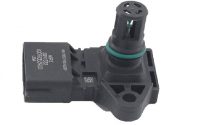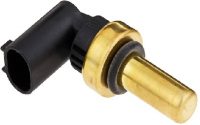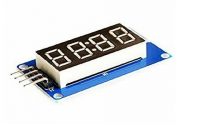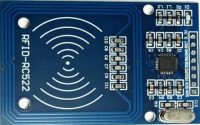What are the Factors We Should Check Before Selecting a Capacitor
Capacitor plays a vital role in the present electronic world. Every device requires capacitors. Choosing the type of capacitor is also very important, as it is available for in different forms and with different ratings. Everything will be discussed in detail and all the points are kept in simple words which help easy to understand. The history of a capacitor was started from 1745 and many improvements had taken place from eminent scientist. The advanced capacitors, what we are using now was developed in 1957 by the scientist named H. Becker. In the process of development, each capacitor had played a significant role in the electronic world. Life was made so simple with a capacitor.
What is a Capacitor?
Capacitor belongs to the passive element system. It stores electric charge temporarily and statically as a static electric field. It is of two plates which are parallel conducting plates and separated by no conducting plates i.e. A region which is called dielectric. It will be ceramic, aluminum, air, vacuum, etc.
The capacitor formula is represented by
C = EA/d
- Capacitance (C) is proportional with the Permittivity ℰ of dielectric medium and proportional to the area of the two conducting plates (A).
- The value of the capacitance depends on the distance between the plates (d).
- The larger the area of the plates separated by a small distance, the greater the capacitance and located in a high Permittivity material.
- By varying E, d or A one can easily change the value of C.
- Unit of the capacitor ‘Farad’. But it is usually found in micro farad, Pico farad and nano farad.
Charging a Capacitor
Dielectric plays a key role in categorizing the capacitors. The factors to be considered are
- Operating voltage
- Size
- Leakage resistance
- Allowable tolerance, stability
- Prices
If a higher value of capacitance (C) is required than the increase in the cross-sectional area of dielectric or to reduce the distance of separation or to use dielectric material with stronger Permittivity.
Types of Capacitors
The various types of capacitors are:
- Paper Capacitor
- Ceramic Capacitor
- Electrolyte Capacitor
- Polyester Capacitor
- Poly Carbonate Capacitors
- Variable Capacitor
Paper Capacitor
It is the simplest form of capacitors. A waxed paper is kept between two aluminium foils i.e. Sandwiched. Cover the aluminium foil with a waxed paper. Again cover this waxed paper with another foil. Now, roll up this as a cylinder. Put two metal caps at both ends of the roll. This whole assembly is set to be enclosed in a case. By the process of rolling it, a large cross-sectional area of capacitor assembled in a reasonably smaller space.
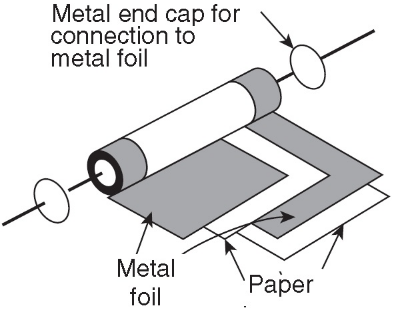
Ceramic Capacitor
It is quite simple in construction in ceramic capacitor. Between two metal discs a one thin ceramic disc is placed and these terminals are soldered to the metal discs. Everything is coated with an insulated protective coating.
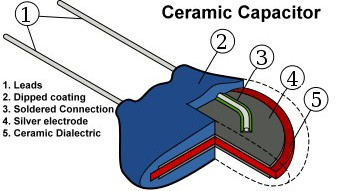
Electrolyte Capacitor
Electrolyte Capacitor is used for very large values of capacitance which can be easily achieved by this type of capacitor. It will not only suffer from high leakage current but also working voltage level of this electrolyte capacitor is low. The use of electrolyte in capacitor it will be polarized, which is the main disadvantage.
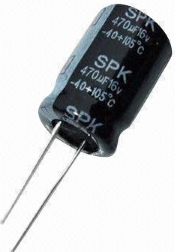
To make an electrolyte capacitor a tantalum oxide film or a few micrometer thickness of aluminium oxide is used as a dielectric. Here the capacitor value will be very high as the dielectric will be so thin. This is because; thickness of the dielectric is inversely proportional to the capacitance. The working voltage of the device is reduced. A special case of electrolytic capacitor is Tantalum. This type capacitors are smaller in size than the capacitors which is of aluminium for the same capacitance value. That is why, for very high value of capacitance, aluminium type electrolyte capacitors are not used for the high value of capacitance. Tantalum type electrolyte capacitors get used in such cases.
| S No | Material | Dielectric Constant | Dielectric Strength Volts/.001 inch |
| 1 | Air | 1 | 80 |
| 2 | Mica | 4-8 | 1800 |
| 3 | Porcelain | 5 | 750 |
| 4 | Paper (Oiled) | 3-4 | 1500 |
| 5 | Glass | 4-8 | 200 |
| 6 | Titanates | 100-200 | 100 |
Polyester Capacitor
Polyester capacitor is also called as Mylar PET. It provides an ideal solution to the requirement of numerous capacitors. Polyester film for the dielectric is placed in between the two capacitor plates. Its properties are unique. The polyester dielectric based on chemical esters. Polyesters include both synthetic materials and naturally occurring.
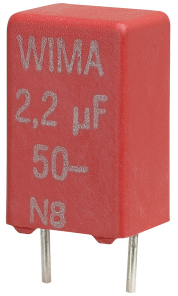
The summary of properties of polyester capacitor Dielectric
| S No | Property | Value |
| 1 | Temperature coefficient (ppm/oC) | +400_+200 |
| 2 | Capacitance drift | 1.5 |
| 3 | Dielectric constant (@ 1MHz) | 3.2 |
| 4 | Dielectric absorption (%) | 0.2 |
| 5 | Dissipation factor | 0.5 |
| 6 | Insulation resistance (MΩ x µf) | 25000 |
| 7 | Maximum temperature (oC) | 125 |
Polyester capacitor applications include
- It handles high peak current levels
- De- coupling and coupling applications and DC blocking.
- Polyester capacitor filters the high tolerance levels where it is not required.
- It is used in Audio applications
- Power is supplied to very high capacitance lelvel of electrolytic capacitors where it is not needed.
Polycarbonate Capacitor
Its dielectric material is very stable. Polycarbonate capacitor will have a high tolerance. It can operate from a temperature of range -55°C to +125°C. In addition to this, the dissipation factor and insulation resistance are good. These capacitors belongs to a group of thermoplastic polymer.
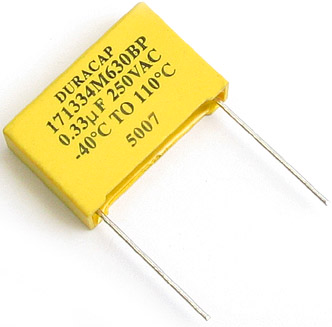
Polycarbonate capacitor is very stable and offers the possibility of high tolerance capacitors which can be used for any temperature range.
The Properties of Polycarbonate are
| S No | Parameter | Value |
| 1 | Volume resistivity | Ωcm |
| 2 | Water absorption | 0.16% |
| 3 | Dissipative factor | 0.0007 @ 50Hz |
| 4 | Dielectric strength | 38 kv/mm |
| 5 | Dielectric constant | 3.2 |
From a solvent casting process dielectric is made and performs best as a metalized. Metallised electrodes are used just for the connections, construction purpose The Metallized types feature vapor deposited metal electrodes. It removes any short circuit or fault by vaporizing the electrode in the region of the short and restores the capacitor to useful life.
Polycarbonate Capacitor Applications
- It is used as a filter, timing and precision for coupling application
- Precision capacitors where it is needed (less than ±5%).
- Used for AC applications.
Variable Capacitor
In a variable capacitor the capacitance may be repeated and intentionally changed electronically or mechanically. These Variable capacitors used mostly in LC circuits which set the resonance frequency. Variable capacitor is used in tuning the radio. It is also called as tuning condenser or tuning capacitor or as variable reactance. It is also used for impedance matching in antenna tuners.
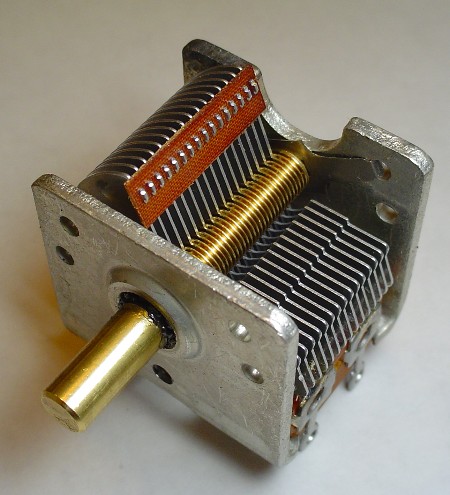
The factors to be looked at before choosing a capacitor are
- Stability: The value of the capacitor changes with the time and temperature.
- Cost: It should be economical
- Precision: +/- 20% is not common
- Leakage: Dielectric will have some resistance and will leak for DC current.
- The Target PF and current Power Factor at site
- The Average & Maximum Demand in KVA or KW at the proposed site of installation
- Nature of Load of the Site.
- The availability of space at the site of installation, power cables etc.
The temperature coefficient of capacitance is manufactured by taking the reference of 25 degree Centigrade.
The Capacitor Tolerance
|
Code |
Tolerance |
| B | ± 0.1 pF |
| C | ± 0.25 pF |
| D | ± 0.5 pF |
| F | ± 1% |
| G | ± 2% |
| J | ± 5% |
| K | ± 10% |
| M | ± 20% |
| Z | +80%, –20% |
Capacitor Polarization will have polarity whereas for non polarized will not have polarity.
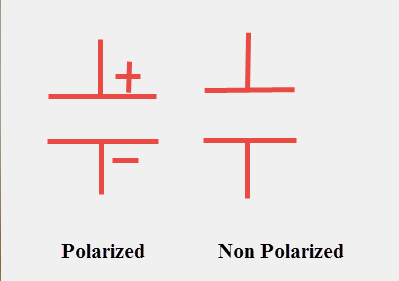
General uses of Capacitors
- It is used for smoothing in power supply applications when required to convert the signal from AC to DC.
- Signal coupling and decoupling as a capacitor coupling.
- It used for electrical power factor correction.
- In radio systems, LC oscillator is connected for tuning to the desired frequency.
- Used for the fixed discharging and charging time of the capacitors.
For Storing Energy. - It allows an AC current to pass and blocks DC current in circuits.
- The frequency of any signal you’re trying to couple or noise you’re trying to suppress
- Minimum/maximum value required
- Desirable value
- Package/lead style
- Operating/maximum voltage
- Tolerance
- Equivalent series resistance
- Polarized ok? Or need non-polarized
- Operating temperature
- Tolerance including temperature coefficient
- Leakage
- Size requirement
- Price objective
- Price budget
- Customer’s prejudices
- Availability/lead time
- Lifetime requirement
- ROHS requirements
- Sample availability
- Tape and Reel
- Manufacturer’s reputation
Thus, this is all about a capacitor, different types of capacitors and what are the factors we should check before selecting a capacitor. We hope that you have got a better understanding of this concept or capacitor color codes with working, please give your valuable suggestions by commenting in the comment section below. Here is a question for you, What are the practical ramifications of capacitors?
Photo Credits:
- Paper Capacitor electricalbasicprojects
- Ceramic Capacitor interfacebus

